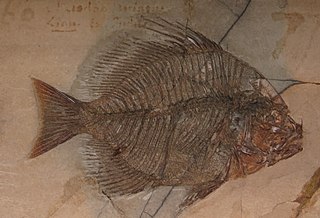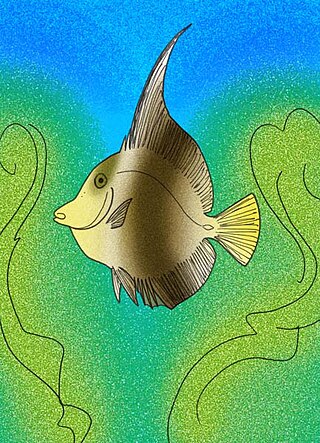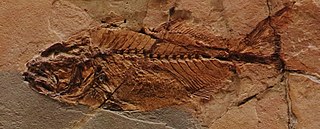
Pycnodus is an extinct genus of ray-finned fish from the Eocene period. It is wastebasket taxon, although many fossils from Jurassic or Cretaceous are assigned to this genus, only Eocene species, P. apodus is valid. As its name suggests, it is the type genus of Pycnodontiformes.

Ceratoichthys is an extinct genus of lookdown-like prehistoric jackfish that lived during the late Ypresian epoch, of the Early Eocene. It contains a single species, C. pinnatiformis of Monte Bolca, Italy. It and Vomeropsis are the only known members of the extinct subfamily Vomeropsinae.

Proaracana dubia is an extinct, prehistoric aracanid boxfish that lived during the Lutetian of middle Eocene Monte Bolca.

Spinacanthus cuneiformis is an extinct prehistoric tetraodontid bony fish that lived from the Lutetian epoch of Eocene Monte Bolca.

Aeoliscoides is an extinct genus of prehistoric ray-finned fish that lived from the early Eocene. It is known from a single species, A. longirostris, from the famous Monte Bolca site of Italy. It was a member of Centriscidae, making it a relative of modern shrimpfish and snipefish. Its name references its close resemblance to the extant shrimpfish genus Aeoliscus.
Calamostoma is an extinct relative of the ghost pipefish that lived during the early Eocene. It contains a single species, C. lesiniforme from the famous Monte Bolca site of Italy. It is one of the few known fossil ghost pipefishes. Calamostoma and the other Bolca solenostomid, Solenorhynchus, are both placed in the extinct subfamily Solenorhynchinae.
Anguilloides is an extinct genus of prehistoric marine eel that lived in the early Eocene. It contains a single species, A. branchiostegalis. Fossils are known from the famous Monte Bolca site of Italy.

Bolcyrus is an extinct genus of prehistoric marine eel that lived during the Early Eocene. It was a member of the family Congridae, which also contains modern conger eels.

Acanthonemus is an extinct genus of prehistoric marine ray-finned fish that lived from the early Eocene. It contains a single species, A. subaureus, known from the famous Monte Bolca site in Italy. It is the only genus in the extinct family Acanthonemidae.

Coelogaster is an extinct genus of marine ray-finned fish that lived during the early Eocene. It contains a single species, C. leptostea, known from the famous Monte Bolca site of Italy.

Eolactoria sorbinii is an extinct prehistoric boxfish that lived during the Lutetian epoch of the middle Eocene, in Monte Bolca. It had two pairs of long spines, one over each eye, and one pair beneath the anal and caudal fins, arranged very similarly to those possessed by the modern genus Lactoria, but were, in comparison, much longer. E. sorbinii had a fifth spine between the two eye-spines, arranged and looking very much like a nose.

Archaephippus is an extinct genus of prehistoric spadefish that lived from the early Eocene. It contains a single species, A. asper, known from Italy. Several exquisitely preserved fossils have been found from the Monte Bolca lagerstatten. Some juvenile specimens preserve the vertical striped coloration that they would have likely had in life.
Callipteryx is an extinct genus of prehistoric marine trachiniform fish that lived during the early Eocene. It is the only known member of the extinct family Callipterygidae. It is thought to have been a relative of weeverfishes.

Eozanclus brevirostris is an extinct relative of the Moorish idol that lived during the late Ypresian epoch of the Eocene in what is now Monte Bolca, northern Italy. It differs from its living relative by having a much shorter snout.

Carangopsis is an extinct relative of the bluefish that lived during the early Eocene. It contains two species, both from the famous Monte Bolca site of Italy.

Carangodes is an extinct genus of prehistoric ray-finned fish that lived during the early Eocene. It contains a single species, C. bicornis, from the famous Monte Bolca site in Italy. It is the only known member of the extinct perciform family Carangodidae.

Eoplatax is an extinct genus of prehistoric spadefish that lived during the Lutetian of Monte Bolca. They are closely allied to the extant genus, Platax, more commonly known as "batfish."
Acanthopygaeus is an extinct genus of prehistoric marine perciform fish in the family Siganidae. It is known from the Eocene lagerstätte "Pesciara" in Bolca, Italy.

Protobalistum imperiale is an extinct prehistoric tetraodontid bony fish that lived from the Lutetian epoch of Eocene Monte Bolca.

Spinacanthidae is an extinct prehistoric family of tetraodontid bony fish that lived from the Lutetian epoch of Eocene Monte Bolca.














